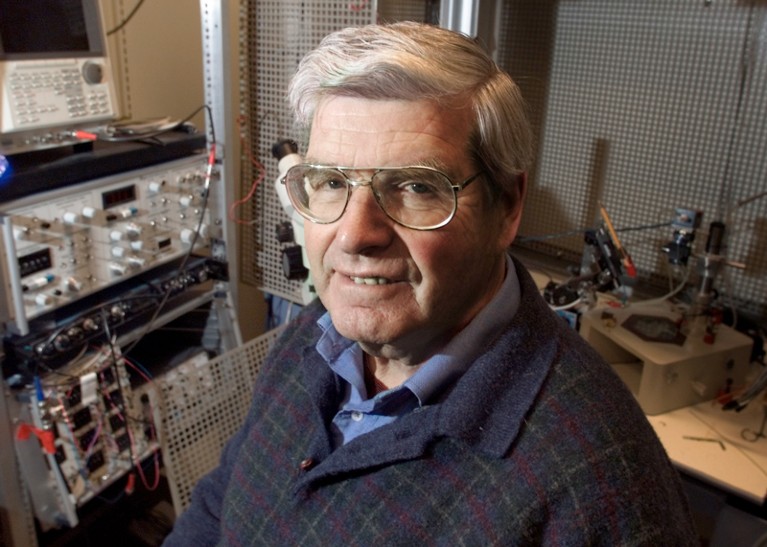
Credit: Dag W. Grundseth/Aftenposten/NTB scanpix
There was something of the Viking about Per Andersen. The intrepid and steadfast Norwegian was renowned for his attacks on the deepest puzzle of the brain: how its wiring and electrical activity give rise to behaviour and experience.
When he was a student in the 1950s, most neuroscientists studied accessible parts of the mammalian nervous system — the junctions between nerves and muscles, say. Andersen worked on the cerebral cortex, which processes higher-level functions: perception, voluntary movement, planning and abstract thinking. His pioneering recordings of electrical activity in the hippocampus — a part of the cortex involved in memory — launched a new era in physiological understanding of the brain and laid the foundations of modern systems neuroscience. He died on 17 February, aged 90.
In 1949, it was predicted that learning might depend on repeated activity strengthening the connections — synapses — in networks of neurons. Andersen saw that this was the case in the hippocampus. As the effect was too fleeting to account directly for memory storage, he encouraged his student Terje Lømo to investigate. In 1973, in one of the greatest discoveries of twentieth-century neuroscience, Lømo and British visiting scholar Tim Bliss reported from Andersen’s laboratory that many bursts of electrical stimulation at certain frequencies enhanced connectivity for hours or days. This phenomenon — long-term potentiation (LTP) — remains the main explanation for how we form and store memories (T. V. P. Bliss and T. Lømo J. Physiol. 232, 331–356; 1973).
We met Andersen as students, in the late 1980s. Our work with him on LTP and animal learning found differences in function between regions of the hippocampus and demonstrated changes in connectivity related to behaviour. His hunch that we should record activity from single cells led to our discovery of specialized neurons in the cortex that support the sense of where the body is in space. The work was a direct result of his insight.
The son of a teacher, Andersen grew up in Oslo, where he studied medicine. Assisting in dissection classes in the early 1950s, he met Jan B. Jansen and Alf Brodal, founders of the influential Oslo School of Neuroanatomy. There, Theodor Blackstad had used an innovative technique that stained only degenerating nerve fibres, to map their routes to specific regions on identified hippocampal cells. This helped Andersen decide to focus on the hippocampus for his doctorate in the institute’s new electrophysiology laboratory. He inserted pairs of fine electrodes into target regions in the brains of anaesthetized rabbits, rats and cats, stimulating fibres with weak currents through one electrode, and recording distinct electrical potentials in nearby cells with the other. In four single-author papers published in 1959 and 1960, which formed his PhD thesis, he established how connectivity in the hippocampus might underlie the electrical responses of its neurons (see, for example, P. Andersen Acta Physiol. Scand. 47, 63–90; 1959).
From 1961 to 1963, Andersen worked with John Eccles at the Australian National University in Canberra. Studying reflex pathways in the spinal cord, Eccles had shown that the transmission of signals at synapses depended on the interplay between multiple inputs that individually either excite or inhibit the firing of the receiving cell. In the hippocampus, using similar methods, Andersen and Eccles together pinpointed the first inhibitory synapse in the brain, going from basket cells to the bodies of pyramidal cells.
Back in Oslo late in 1963, Andersen set up his own lab and continued to map the hippocampal region. He realized that the fibres of the neural pathways through it run parallel. This gave him the idea to study brain function in a lab dish. In 1971 his students Knut Skrede and Rolf Westgaard published the method of taking a slice through the hippocampus oriented to preserve the circuits’ connections (K. K. Skrede and R. H. Westgaard, Brain Res. 35, 589–593; 1971). Fifty years on, neuroscientists still use this preparation for precise, in-vitro study of the function of brain synapses.
By the early 1970s, Andersen’s lab had become a Mecca for studies of the hippocampus, with him as a steady source of ideas and encouragement. Flags strung outside his office showed the nationalities of lab members. Doctoral students were expected to publish at least one paper without their supervisor, and Andersen let them work independently on some of the best projects in his lab, always ready with advice, interpretation and resources.
Andersen was competitive — he joked that we had to beat our neighbours, the Swedes — but friendly and respectful, too. Visiting scientists would accompany him and his wife Kari to their mountain cabin or on their sailing boat. After we and four other students defended our PhD theses in December 1995, he took us and all 18 examiners — world leaders in their fields — out on horse-drawn sleighs to a forest cabin to celebrate and sing sea shanties.
During the 1980s and 1990s, Andersen broadened his research in two directions. First, he wanted to understand the molecular basis of LTP, and explored, for example, the role of specific subtypes of receptors for the neurotransmitter glutamate. He also studied the behavioural significance of LTP and neural circuits involving the hippocampus. It was during this last period that we joined his team. His death marks the end of a pioneering era.

 Brains of Norway
Brains of Norway
 Decoding the development of the human hippocampus
Decoding the development of the human hippocampus







